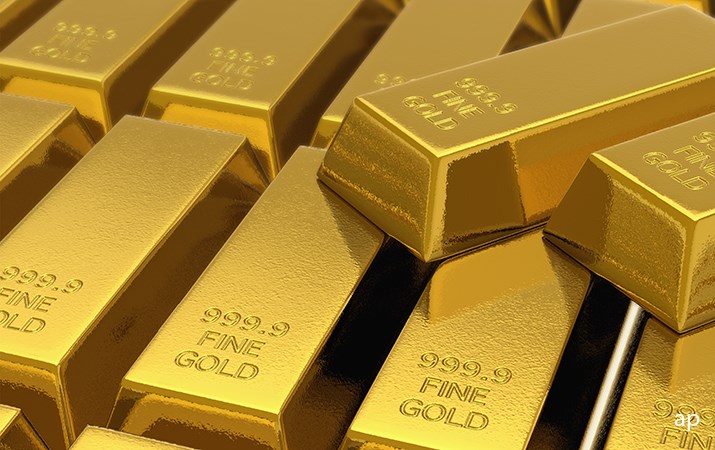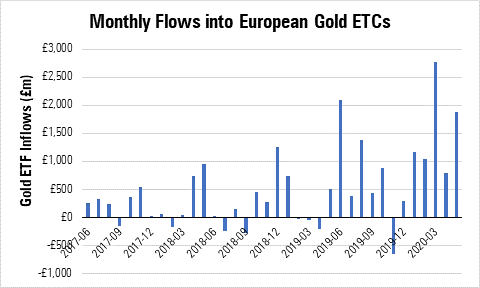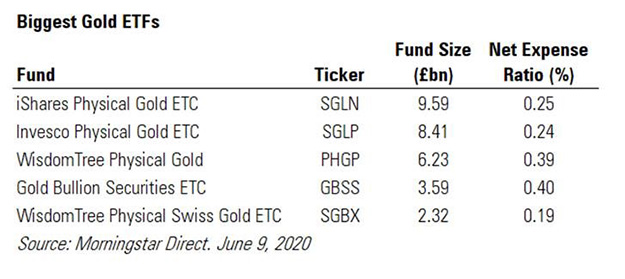
Investors have poured record amounts of money into gold funds in the wake of the Covid-19 crisis as a global stock market sell-off prompted a flight to safe haven assets.
Inflows into gold exchange-traded funds (ETFs) in the first five months of 2020 have already topped the records for any full calendar year on record, according to the World Gold Council.
Globally, investors have funnelled a staggering $33.7 trillion into gold ETFs year to date, equivalent to 623 tonnes of the precious metal. That far eclipses the previous record of 591 tonnes added to portfolios in 2009 as a whole.
Morningstar’s own monthly flows data indicates a peak of inflows in March as stock markets tumbled, with an easing off the following month before another pick-up in May.

This flood of investment is, perhaps, not surprising at a time of such great uncertainty. The gold price is up around 28% over the past year to more than $1,700 an ounce. The yellow metal has outperformed most other major asset classes this year, and stands out among other popular commodities, particularly oil, which is down almost 40% over the past 12 months.
Kenneth Lamont, passives analyst at Morningstar, says: “In times of economic uncertainty, gold comes into its own as a store of value. For investors who are unconvinced by the rebound in stock markets, increasing your allocation to gold is a way of buying crash insurance for your portfolio.”
The flight to safety has seen assets under management in the iShares Physical Gold ETC (SGLN) swell to £9.59 billion and the Invesco Physical Gold ETC (SGLP) reach £8.41 billion.
The Royal Mint’s recently-launched exchange-traded product has now reached £272 million of assets under management. The Royal Mint Physical Gold ETC (RMAU) is the first gold fund to be backed by a European Sovereign Mint. Interestingly, the gold backing the fund is responsibly sourced from a conflict-free origin, making it a viable option for ESG-focused investors.
Lamont says: “The Royal Mint’s ETC isn't among the largest gold ETCs but, with a fee of 0.22% it is very competitively priced.” The gold it tracks is custodied at the government-owned and Ministry of Defence-protected Royal Mint vault in Wales, meaning it is removed from the commercial banking market. “This may appeal to those investors buying gold as ‘armageddon insurance’,” says Lamont. “Even better, it is the only gold ETC to be fully-backed by responsibly-sourced gold bars.”
Can Gold’s Golden Run Continue?
The outlook for gold from this point largely depends on investor sentiment regarding economic growth and inflation.
To fight the effects of Covid-19, central governments have been ramping up borrowing and monetary stimulus, which often leads to a weakening of currencies and gold becomes particularly attractive when the value of the dollar falls.
Meanwhile central banks have cut interest rates, which means yields on fixed income investments such as UK government Gilts and US Treasuries fall, which also makes gold more appealing.
Other tailwinds include an expected rise in inflation, the likelihood of a severe recession and rising unemployment, and the continuation of trade tensions between the US and China. Paul Jackson, global head of asset allocation at Invesco, explains: “Gold benefits when you think there is going to be a recession; it tends to do better in the worst-case scenarios than in the best-case or recovery scenarios.”
Jackson has been overweight to gold for some time and for those bullish on the metal he thinks exposure to the bullion itself may be the safest strategy. While gold mining companies can benefit as the gold price rises – therefore increasing their profit margins – they also face the same challenges as other businesses the world over currently.
“There are going to be a lot of failures out there, a lot of bankruptcies, and if you’re buying equities of any form right now you need to be careful not just about the risk to earnings and dividends, but the bankruptcy risk that exists,” says Jackson. “Because of the extraordinary circumstances and the depth of the recession in which we find ourselves, I feel that physical gold is the better way to go.”
For investors looking to gain exposure to physical gold, ETFs are often the simplest and cheapest way to do so and you can read more on how they work here. These low-cost funds aim to track the spot price of the precious metal, rather than investing in gold-related equities as other types of fund might.

Among the cheapest options is WisdomTree Physical Swiss Gold ETC (SGBX), which charges just 0.19% and has delivered a return of 15.52% year to date. The largest fund is iShares Physical Gold ETC, which charges 0.25% and is up 15.46% so far this year.
View the latest pricing and investment return data on gold stocks available in the market.



























